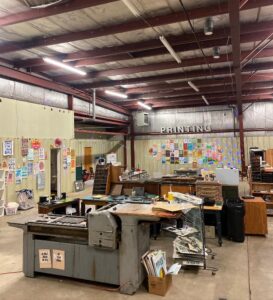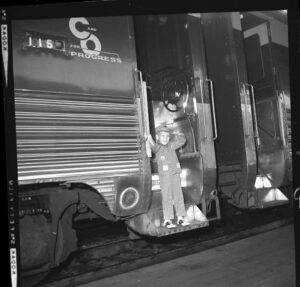The Chesapeake & Ohio Historical Society’s campaign to restore the famous railroad passenger car “Chessie 29” is getting a boost, thanks to a collaboration between the non-profit organization and Base Camp Printing Company of Charleston, West Virginia.

Owners Emily and Betsy Sokolosky harnessed their vintage printing expertise to manufacture a custom-designed poster the C&O Historical Society is now selling to fundraise for and promote Chessie 29’s return to the rails. The sister-owned shop strives to keep their process identical to when letterpress printing was modern technology, which C&OHS explains is what initially caused the historical group to reach out to the owners with their proposal.
The 54-year-old organization that preserves and shares the history of the Chesapeake & Ohio Railway is undertaking one of its largest and most historically-significant efforts with its goal to restore Chessie 29, the most famous surviving passenger car from the railroad, to operational condition. While the Charleston-based print shop may be best known for its designs paying tribute to the Mountain State, the former C&O Railway passenger car highlighted in their latest piece has historical connections to the state that made the partnership especially appropriate.
Chessie 29 holds a famous distinction in West Virginia history because of its multiple connections to The Greenbrier at White Sulphur Springs. Most notably in the car’s history, in 1956, C&O Railway President Walter Tuohy, to whom Chessie 29 was permanently assigned, and President Dwight Eisenhower traveled on board together from Washington to White Sulphur Springs. During this trip, the agreement was made through which the United States government constructed its top-secret bunker under The Greenbrier to house members of the U.S. Congress in the event of a nuclear attack on the nation’s capital. Arriving in the Mountain State together on Chessie 29, the guise for the meeting was the “Summit of the Americas” at The Greenbrier with other North American leaders.

In reality, it was at this time that Mr. Tuohy and President Eisenhower agreed upon a collaboration by which the federal government funded construction and future staffing of a bunker complex with cut-and-cover concealment, disguised under a to-be-constructed wing for The Greenbrier, which the Chesapeake & Ohio Railway owned at the time. This bunker, meant to house and allow the surviving United States Congress members to function following an attack, was staffed and kept ready for possible use from the period just before the Cuban Missile Crisis until 1992.
Describing the future mission for a restored Chessie 29, C&O Historical Society President Mark Totten summarized, “Because it is such an irreplaceable asset, we have prioritized saving this piece of rolling history and returning it to operational condition as a mobile museum and teaching tool for future generations.”
Base Camp Printing Company’s poster design for the C&O Historical Society is inspired by a photograph from the organization’s archive showing Chessie 29 at the Logan, West Virginia train station, which still stands today in use as city hall. To create the pieces necessary to finish each poster, Emily and Betsy Sokolosky hand carved linoleum blocks and printed each block one at a time, one poster at a time.

The process required carving separate blocks for the navy, yellow, and green colors used in their depiction of the scene at Logan. Adhering to the traditional practices that have made the sister-run shop so unique in the 21st century, the Chessie 29 poster was completely printed on Base Camp Printing Company’s 1950sera Vandercook printing press, which the shop uses for printing all poster designs.
While in the early stages of discussion about possible poster designs, the C&O Historical Society provided a portfolio of vintage Chessie 29 photographs and data to Base Camp Printing. When asked about the reason for picking this scene to re-create for the C&OHS’s fundraising campaign, Emily Sokolosky stated, “We were inspired by the photograph of Chessie 29 at the Logan, West Virginia train station. We loved the juxtaposition of the dynamic Chessie 29 with the mountains in the background. We took some artistic liberties in the design, but kept the essence of the photograph.”
Especially because the Cold War produced so disproportionately few artifacts that can now interpret that period to future generations, the C&O Historical Society emphasized that Chessie 29‘s restoration is urgently relevant to the wider context of world history as well as their organization’s traditional focus on Chesapeake & Ohio Railway history. C&OHS President Mark Totten explained, “In the context of the Cold War’s fears and our country’s necessary reactions to them, Chessie 29 is the ‘room where it happened’ for what is now nearly unthinkable, as the secret bunker was to be vital for the continuity of our legislative branch of government.”

As the personal business car of the railroad’s charismatic president, Chessie 29 also intersected with history in other ways during its service life on the C&O. In 1952, Mr. Tuohy hosted Queen Juliana and Prince Bernhard of the Netherlands on board the car in Michigan. In 1963, Mr. Tuohy loaned the car to Monaco’s Prince Rainier III and Princess Grace for its discreet, comfortable transport along with their two children to The Greenbrier in West Virginia on a private vacation. The royal trip included a young Albert II, the current reigning Prince of Monaco, to whom Tuohy gifted a railroad engineer’s uniform that he thoroughly enjoyed wearing while on board.

C&OHS President Totten remarked, “On the list of surviving equipment from America’s golden age of railroad travel, few passenger cars carry the historical richness and connections to world history like Chessie 29.” At their peak, the Chesapeake & Ohio Railway’s passenger trains ran from the Virginia shore, throughout Appalachia, and to Michigan.
Owner Emily Sokolosky expressed her feelings about Base Camp Printing Company’s new role in the campaign to restore the famous passenger car, “As letterpress printers, we appreciate preserving history. So, we felt honored to create a piece of art of the Chessie 29 to help fundraise for its restoration. We strongly believe in preserving the past so generations can appreciate it. We felt this collaboration was a match made in heaven.”
Using American-based manufacturers wherever possible when developing items for sale in support of their non-profit organization and its projects, the C&O Historical Society recently collaborated with two other West Virginia manufacturers, the Fiesta Tableware Company of Newell, to re-create a historically accurate reproduction of the Chesapeake & Ohio Railway’s last china pattern used in its dining car service, and the Blenko Glass Company of Milton, to commemorate the City of St. Albans’ railroad history with a custom design incorporated into the glassmaker’s famous 384 water bottle.
Totten expressed gratitude toward Emily and Betsy Sokolosky for such a successful collaboration, “It was pure joy and an honor to collaborate with Base Camp Printing Company on this artwork promoting our project, but we are especially excited to further share the story of Chessie 29’s significance to West Virginia history and the history of the Cold War.”

Reflecting on Base Camp Printing Company’s involvement with the Chessie 29 campaign, owner Emily Sokolosky stated, “This project is why we do what we do. We love creating art that promotes a deeper understanding and appreciation for history and the past. Combining the history of printing with the history of the C&O is a dream collaboration that we are so honored to be a part of.”
Closing upon the significance of the rail car’s early role with The Greenbrier’s secret bunker complex that would have been used only in the darkest of days, Totten remarked about the poster’s tranquil tone, “Fortunately for the world, that unthinkable scenario never materialized, which makes Base Camp’s depiction of Chessie 29 in such a peaceful scene the perfect choice.”
Measuring 11″ x 17″, this limited 50-unit run of Base Camp Printing Company posters made for the C&O Historical Society’s fundraising campaign to restore Chessie 29 are on sale on the non-profit organization’s retail website, ChessieShop.com. Orders may also be placed by contacting the organization’s Business Office by telephone at 540-862-2210, Monday-Friday, 9 AM – 5 PM, or by email at [email protected]. These limited-run, C&OHS-exclusive posters are $75.00.
Base Camp Printing is a letterpress shop and design studio based in Charleston, West Virginia. Owners Emily and Betsy Sokolosky specialize in handmade posters, stationery, and original art. The sisters strive to keep the shop’s process identical to when letterpress printing was modern technology.
The C&OHS archive database is available online at archives.cohs.org. Updates and additional information can be found on Facebook under @cohs.org or on Instagram @ChessiesRoad.

